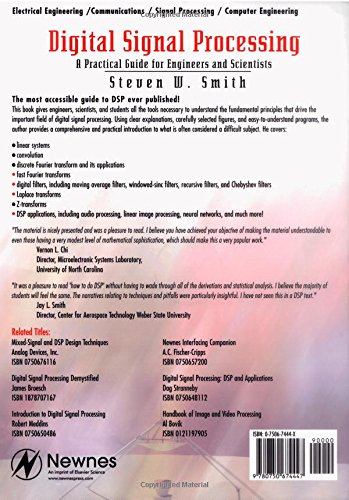Customer Services
Copyright © 2025 Desertcart Holdings Limited
Desert Online General Trading LLC
Dubai, United Arab Emirates




Digital Signal Processing: A Practical Guide for Engineers and Scientists
G**F
This is the one to get ! It really is practical.
This is the one to get ! It really is practical. Dr Smith covers the theory properly, and then gives BASIC code to implement the theory. Before you say "Yuk, BASIC", the BASIC code which Dr Smith uses is so simple that converting to C or Assembler is trivial, but being BASIC, the algorithms are really easy to understand by everybody especially important for non-programmers, and one doesn't spend time trying to figure out the programming language specifics.You can also download the electronic version from [...] Steve Smith is generous enough to let us get a complete electronic copy for free, but so useful was the electronic copy that I just had to also get a real physical copy !I used Dr Smith's book to help me to write all of the DSP parts of the G8JCFSDR (a Software Defined Radio) way back in 2004/5 see [...]
K**N
Terrible Print Quality. Content superb
The content is good. But the quality of book produced is terrible. Text actually bleeding right into binding on central spine make it a horrible experience to read. I had to return it and will now purchase the older hardback version. Appaling price for such bad quality by the publishers. Disgraceful to be honest. Although the content which I am now reading online is superb. I am sorry that reviews like this will damage the authors sales. But people need to know what they are getting when such a high price is being levied. I'd have had no issue paying it if the physical book was actually of decent quality. I would suggest the author move to a different publisher.
G**S
Simply a Gem
It does exactly what it says on the title while providing valuable insights in every chapter. I think it would be more appreciatd by for those who already have some dsp background, like I did, where the insights more than make up for mathematical rigour easily found in many other books. This book is a commendable effort by the author who despatches with clarity and authority on the subject.On an other note completely the publisher Newnes - Elsevier did slip up big timeon quality control; the book had the whole of chapter 8 missing, part of 9 missing but instead had two repeated chapters 6 & 7 !! How about that Elsevier? Just as well that the book seller refunded the cost and that a pdf version was supplied with the book. Not expected of a costly book made in USA!
P**C
DSP explained!
I used this book to develop a Java app for my MSc Computer Science project. Having completed a Music Tech BSc I felt I had no understanding of how digital filters work. DSP is fundamental to contemporary Music Technology and underpins much of the wizardry that makes modern music production possible. I converted the BASIC programs listed in the book to Java and incorporated them in my app which I have made available for inspection [...]. The support was unbelievable, I had a problem with a particular filter where I was unable to reproduce exactly the results in the book although it looked as if the filter was basically working. In desperation I emailed the author and over a few days he helped me resolve the issue which was in my code and not his, and this despite the fact that he wrote this book many years ago.I would recommend this book to anyone wishing to get to grips with DSP. I can supply my Java versions of the basic code if anyone is interested.
R**D
Brilliant example of technical writing
This book stands out as an example of clear technical writing.Every concept is introduced carefully and is explained 3 ways: with equations, with example graphs, and with code.The equations are always explained and they start very simple (taking the mean of samples). Every equation has a margin note reminding you what it's about and what all the variables mean - ideal if you delve into the book, or pick it up after a few days, you don't have to go back pages to try to find out what the nomenclature is.The graphs are by way of examples. For instance when explaining signal to noise ratios there are graphs of signals with various ratios so you can get a feel of how corrupted these signals would be.The code is simple. I was shocked innitially because it's in BASIC! Yuck. But in fact this doesn't matter, it's short, simple, commented, and can be straightforwardly translated into some other language. It does the job.The book leaves the hard maths to the end, which is a real relief after other DSP books and web articles. But it's there, and the author really succeeds in getting across the "meaning" of Laplace and Z spaces.There are some unexpected inclusions, such as a large section on neural networks - I had not seen this covered as DSP before.This book would suit either for student study (there are no exercises), or stand-alone for those wishing to implement some DSP in a real design.There's a CD-ROM whivh I haven't looked at. As far as I know it includes all the code samples - one improvement might be for these to be included in C, if only on the disk.
Trustpilot
1 week ago
2 months ago
2 weeks ago
3 weeks ago